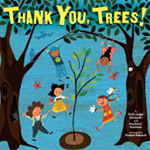WHEN IT COMES TO TEACHING gratitude, no lesson is complete without real-world demonstrations. Whether those demonstrations come via characters in a PJ Library book or, even better, through the actions of trusted adults in their everyday lives, children need to observe behavior before they can emulate and master it.
 As Kristen Steward and Dr. Pat Bass explain in their Everyday Health article, “Teaching Kids the Importance of Gratitude,” behavior modeling is critical for toddler development.
As Kristen Steward and Dr. Pat Bass explain in their Everyday Health article, “Teaching Kids the Importance of Gratitude,” behavior modeling is critical for toddler development.
“Ultimately, gratitude can help adults and children alike,” Steward and Bass write, “and the best thing parents can do is be a good role model for their children.”
MODELING ‘THANKS’
It’s not always easy to say “thank you.” When your great-aunt Sandy gives your son a Lego set he already owns, for example, he may feel obligated to force out words of thanks. Similarly, when you yourself are given an object that really only brings clutter to your home, you too may feel it is expected and appropriate to say “thanks” despite feeling less than grateful for the object.
The key to gratitude is honesty and distinction. You may not feel thankful for the object, but you may find it in your heart to feel thankful for the gesture and the giving.
Popular Kveller.com blogger and actress Mayim Bialik says tries not to force her children to say “thank you.” Rather, she prefers to model grateful behavior and lead by example.
As she explained on the Today Show website’s Parenting blog in her post, “Why I Don’t Force My Kids to Say ‘Please’ … or Walk on Schedule,” Bialik prefers to let her children observe her own behavior and come to their own terms with notions about empathy and thankfulness. The idea, she suggests, is to foster an interest in the concepts of gratitude moreso than to perform the common, expected gestures of gratitude.
“Families that don’t force these things have children who grow and develop at their own pace and they all turn out pretty much fine,” Bialik writes.
SESAME ROLE MODELS
Need a celebrity (or furry) stand-in to demonstrate “thanks”? In the video below, actor Seth Rogan and Shalom Sesame’s Elmo learn the Hebrew word for “thank you” (todah).
“THANKFUL” PJ LIBRARY BOOKS
Below are three PJ book selections that put “thank you” at the hearts of their stories. They, too, can provide demonstrations of gratitude for children.
 |
All of Me: A Book of Thanks
Author: Molly Bang
Illustrator: Molly Bang
From fine feet and grand hands to hearing ears and a thumping heart, this book teaches children and reminds adults to enjoy a sense of gratitude as part of the family in this big, amazing world. |
 |
Thank You For Me!
Author: Rick Recht
Illustrator: Ann Koffsky
Sure, you know it’s polite to say “thank you.” But did you know it can also make you feel great? In this book, based on Rick Recht’s song “Kobi’s Lullaby,” a child realizes he has a lot to be thankful for -- everything from the moon and the sun to his nose and his toes. |
 |
Thank You, Trees!
Authors: Gail Karwoski & Marilyn Gootman
Illustrator: Kristen Balouch
On Tu B’Shevat we show our gratitude for all that trees provide for us. This book also demonstrates for very children how we can all “give back” by caring for trees. |
September 23, 2014